
The mid ‘30’s would see a marked improvement in the genre of circus cartoons – the first episodes to be filmed in Technicolor. Along with this, the general quality of the animation from the major studios was dramatically improving, such that flashy performances could be depicted in smooth, full detail, often against spectacular backgrounds, providing genuine atmosphere for the colorful adventures. Of course, there were always laggers-behind, such as Terrytoons – but even there, as evidenced by the last title on today’s survey, a clever, well-drawn concept could occasionally be churned out.
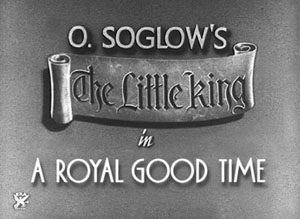 A Royal Good Time (Van Beuren/RKO, The Little King, 4/13/34, George Stallings, dir., Jim Tyer, anim.). Thanks to our bloggers for reminding me of this superior title, here presented slightly out of chronological order. I had vaguely recalled the King in a circus setting, but could not recall the title, and thought the film originated later in the game, so almost missed it. In fact, the King almost misses it, as he botches a grand emergence from the palace, failing to appear behind the curtains at the head of a palace staircase lined with trumpeting heralds, and instead unceremoniously exiting out a side door with horse and sidecar, galloping off with a small marksman’s rifle to perform William Tell’s trick of shooting apples off the heads of a long row of dignified gentleman who conceal the apples under their top hats. Eventually, he reaches a fairgrounds, hosting a show that can’t seem to decide whether it is a carnival or a circus, combining elements of both. The King is attracted by a shooting gallery, where he uses his own weapon to knock off all but one of the moving row of ducks, the last giving him a raspberry and flying away. Next, a sideshow. A fire eater cooks up flames within a frying pan, then carves them with a knife and fork as he swallows them down. The very sight of his act makes the King perspire, causing him to pull out a small hand fan with which to cool himself. A sword swallower takes in the sharp weapon so deeply, it seems to come out his other end and stick into the chair he is sitting on. The suggestion of emergence of the blade through his bottom is quickly dispelled, however, as the man rises from the chair, tearing his pants and revealing that he was only stuck to the chair by a coat of wet paint. In one of the funniest gags of the film, the King visits the tent of the seductive Madame Goona, Mind Reader. She bears some facial resemblance to Mae West, and a demeanor of sophistication about the ways and thoughts of men. She turns for a dispassionate look at the King, who smiles bashfully. Suddenly, her eyes widen as she picks up vibes of the King’s thoughts, and reacts as any self-respecting woman would do – by slapping the King’s face soundly! The King next rides a merry-go-round, but finds it easier to grab for the earrings of its gypsy proprietor than the normal brass rings intended to permit the bearer to win a free ride.
A Royal Good Time (Van Beuren/RKO, The Little King, 4/13/34, George Stallings, dir., Jim Tyer, anim.). Thanks to our bloggers for reminding me of this superior title, here presented slightly out of chronological order. I had vaguely recalled the King in a circus setting, but could not recall the title, and thought the film originated later in the game, so almost missed it. In fact, the King almost misses it, as he botches a grand emergence from the palace, failing to appear behind the curtains at the head of a palace staircase lined with trumpeting heralds, and instead unceremoniously exiting out a side door with horse and sidecar, galloping off with a small marksman’s rifle to perform William Tell’s trick of shooting apples off the heads of a long row of dignified gentleman who conceal the apples under their top hats. Eventually, he reaches a fairgrounds, hosting a show that can’t seem to decide whether it is a carnival or a circus, combining elements of both. The King is attracted by a shooting gallery, where he uses his own weapon to knock off all but one of the moving row of ducks, the last giving him a raspberry and flying away. Next, a sideshow. A fire eater cooks up flames within a frying pan, then carves them with a knife and fork as he swallows them down. The very sight of his act makes the King perspire, causing him to pull out a small hand fan with which to cool himself. A sword swallower takes in the sharp weapon so deeply, it seems to come out his other end and stick into the chair he is sitting on. The suggestion of emergence of the blade through his bottom is quickly dispelled, however, as the man rises from the chair, tearing his pants and revealing that he was only stuck to the chair by a coat of wet paint. In one of the funniest gags of the film, the King visits the tent of the seductive Madame Goona, Mind Reader. She bears some facial resemblance to Mae West, and a demeanor of sophistication about the ways and thoughts of men. She turns for a dispassionate look at the King, who smiles bashfully. Suddenly, her eyes widen as she picks up vibes of the King’s thoughts, and reacts as any self-respecting woman would do – by slapping the King’s face soundly! The King next rides a merry-go-round, but finds it easier to grab for the earrings of its gypsy proprietor than the normal brass rings intended to permit the bearer to win a free ride.
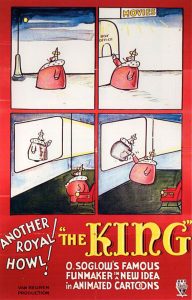 The performance by a swami of the Indian rope trick is abruptly interrupted, when the King appears from nowhere to slide down the rope to the stage. Upset at the interloper, the swami begins an extended chase of the King. They run under the coat of a man billed as the world’s biggest giant, revealing under the coat no less than 23 midgets standing on each other’s shoulders. The King hides for a time within the pouch of a boxing kangaroo, letting the animal do most of the heavy punching of the swami, while the King adds a few low blows once his opponent is softened up. A magician enlarges several playing cards to giant size, and the King briefly fools his pursuer by standing in front of one of them, as if he were an illustrated “king” straight out of the deck. The King finally makes it inside the big top, where he is accidentally launched by a teeter-totter to a two-bar trapeze spinning on a pivoted center. The swami also winds up on the same contraption, via a bite in the rear from a dog-faced boy, and the King is spun upwards through the tent roof, landing at the top of a high-striker on the carnival grounds outside. A muscular man hits the gong from below, jolting the King back into the tent. He collides with the swami, causing them to both fall. The King safely lands balanced atop a low-strung tight-wire. The swami uses the wire like a slingshot, stretching it sideways to its limit with the King still balanced upon it, then letting go. The King again flies through the canvas roof, sailing to the far end of the fairgrounds, where a water tank provides a temporary home for alligators, crocodiles, and hippos. As the King falls in, the beasts all dive at him in the water, and everyone briefly disappears. Finally, up from the water rises a hippopotamus, who opens his mouth, to reveal the King inside, casually playing solitaire on the beast’s tongue. The King exits the hippo’s mouth, reaching back inside to retrieve his crown, then makes a shy, side-stepping exit to abruptly bring the festivities to a close, for the iris out.
The performance by a swami of the Indian rope trick is abruptly interrupted, when the King appears from nowhere to slide down the rope to the stage. Upset at the interloper, the swami begins an extended chase of the King. They run under the coat of a man billed as the world’s biggest giant, revealing under the coat no less than 23 midgets standing on each other’s shoulders. The King hides for a time within the pouch of a boxing kangaroo, letting the animal do most of the heavy punching of the swami, while the King adds a few low blows once his opponent is softened up. A magician enlarges several playing cards to giant size, and the King briefly fools his pursuer by standing in front of one of them, as if he were an illustrated “king” straight out of the deck. The King finally makes it inside the big top, where he is accidentally launched by a teeter-totter to a two-bar trapeze spinning on a pivoted center. The swami also winds up on the same contraption, via a bite in the rear from a dog-faced boy, and the King is spun upwards through the tent roof, landing at the top of a high-striker on the carnival grounds outside. A muscular man hits the gong from below, jolting the King back into the tent. He collides with the swami, causing them to both fall. The King safely lands balanced atop a low-strung tight-wire. The swami uses the wire like a slingshot, stretching it sideways to its limit with the King still balanced upon it, then letting go. The King again flies through the canvas roof, sailing to the far end of the fairgrounds, where a water tank provides a temporary home for alligators, crocodiles, and hippos. As the King falls in, the beasts all dive at him in the water, and everyone briefly disappears. Finally, up from the water rises a hippopotamus, who opens his mouth, to reveal the King inside, casually playing solitaire on the beast’s tongue. The King exits the hippo’s mouth, reaching back inside to retrieve his crown, then makes a shy, side-stepping exit to abruptly bring the festivities to a close, for the iris out.
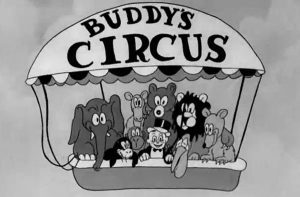 Buddy’s Circus (Warner, Looney Tunes (Buddy), 11/8/34 – Jack King, dir.). Buddy does things a little differently than most ringmasters. A sign on a vacant lot announces that his traveling circus will arrive at 2:00. Instead of the usual circus parade, Buddy and his animals and troupe arrive by hot air balloon. At precisely 2:00, Buddy drops a load of tent stakes to the ground, then lowers on a rope an octopus to drive them in. In a twinkling, the balloon bag unfolds to become the big top, and is open for business in a matter of seconds. The show begins in the menagerie with an unusual act – Professor Buddy and his musical elephants (20 toms of tunes). Four pachyderms of descending sizes are lined up side by side, and Buddy first plays tunes upon their tusks with mallets, then walks around to tug upon their tails, producing calliope music out of their trunks. Buddy next acts as barker for the sideshow, announcing a series of acts performed by African Ubangi. One dancer wears a skirt that appears to be fabricated out of wooden bars, twirling with them while another plays the rotating bars like a xylophone. Another native transforms into the human “Ubangiphone”, placing a phonograph record spinning within his disc-shaped lower lip, while his tongue serves as a needle to play a tune from it. Asbesto, the Human Stove, devours flame, a frying pan, and an egg, cooking up his breakfast internally as demonstrated on a x-ray machine, and producing a burp.
Buddy’s Circus (Warner, Looney Tunes (Buddy), 11/8/34 – Jack King, dir.). Buddy does things a little differently than most ringmasters. A sign on a vacant lot announces that his traveling circus will arrive at 2:00. Instead of the usual circus parade, Buddy and his animals and troupe arrive by hot air balloon. At precisely 2:00, Buddy drops a load of tent stakes to the ground, then lowers on a rope an octopus to drive them in. In a twinkling, the balloon bag unfolds to become the big top, and is open for business in a matter of seconds. The show begins in the menagerie with an unusual act – Professor Buddy and his musical elephants (20 toms of tunes). Four pachyderms of descending sizes are lined up side by side, and Buddy first plays tunes upon their tusks with mallets, then walks around to tug upon their tails, producing calliope music out of their trunks. Buddy next acts as barker for the sideshow, announcing a series of acts performed by African Ubangi. One dancer wears a skirt that appears to be fabricated out of wooden bars, twirling with them while another plays the rotating bars like a xylophone. Another native transforms into the human “Ubangiphone”, placing a phonograph record spinning within his disc-shaped lower lip, while his tongue serves as a needle to play a tune from it. Asbesto, the Human Stove, devours flame, a frying pan, and an egg, cooking up his breakfast internally as demonstrated on a x-ray machine, and producing a burp.
 The show moves into the big top. One unusual act features a clown and lions. The clown, smoking a cigar, lies on his back while the lions each jump on his belly. Each jump produces a smoke ring, for the next lion to jump through before landing on the clown’s tummy, to start the process all over again. The old gag of an acrobat hanging from a set of false teeth is repeated once again. (How this trope would have been rendered meaningless in this day and age of dental implants.) A young baby in the bleachers loses his bag of popcorn in a gap between the seats, then descends below the seating to retrieve it, performing his own trapeze act by swinging hand-over-hand from one board to another. In an arrangement that would seem rather unsafe for the customers, the elephants just happen to be housed under the bleachers, and the infant joins their dancing act in the center ring. Junior sits down after the dance on the end of a teeter-totter, while above, the Africans are performing a trapeze act, with one native swinging from the nose rings of two other natives suspended upside-down from trapeze bars. The rings break, and one native falls, landing on the teeter-totter. Junior is launched to a platform high above, and becomes mixed-up in the swinging of other trapeze artists, knocking one performer loose, and taking his place clutching to another acrobat’s ankles. While the kid has been out before the crowd for nearly two minutes, not-too-observant Mom and Buddy only choose this moment to notice him, and attempt a rescue. They both climb to a high-strung net a short distance below the trapeze act, where Buddy swings a lasso to catch the baby’s waist. The baby falls, his weight in the net bouncing Buddy and Mom upwards, where they now cling to the trapeze artist’s ankles. Junior joins them, grabbing Mom’s ankles, and causing all to fall again. They land upon and take the place of another performer riding a bicycle across the high-wire, but all are jostled off when the bike hits the pole at the end of the wire. All three pop through the roof of the circus tent. Junior lands inside a cage, unseen by Buddy and Mom. Buddy and Mom make their descent to the ground by sliding down the neck of a giraffe, removing his neck spots in the process. They each look around for Junior, who pops up safe and sound inside the mouth of a caged hippopotamus. The three dance in a celebratory circle, for the iris out.
The show moves into the big top. One unusual act features a clown and lions. The clown, smoking a cigar, lies on his back while the lions each jump on his belly. Each jump produces a smoke ring, for the next lion to jump through before landing on the clown’s tummy, to start the process all over again. The old gag of an acrobat hanging from a set of false teeth is repeated once again. (How this trope would have been rendered meaningless in this day and age of dental implants.) A young baby in the bleachers loses his bag of popcorn in a gap between the seats, then descends below the seating to retrieve it, performing his own trapeze act by swinging hand-over-hand from one board to another. In an arrangement that would seem rather unsafe for the customers, the elephants just happen to be housed under the bleachers, and the infant joins their dancing act in the center ring. Junior sits down after the dance on the end of a teeter-totter, while above, the Africans are performing a trapeze act, with one native swinging from the nose rings of two other natives suspended upside-down from trapeze bars. The rings break, and one native falls, landing on the teeter-totter. Junior is launched to a platform high above, and becomes mixed-up in the swinging of other trapeze artists, knocking one performer loose, and taking his place clutching to another acrobat’s ankles. While the kid has been out before the crowd for nearly two minutes, not-too-observant Mom and Buddy only choose this moment to notice him, and attempt a rescue. They both climb to a high-strung net a short distance below the trapeze act, where Buddy swings a lasso to catch the baby’s waist. The baby falls, his weight in the net bouncing Buddy and Mom upwards, where they now cling to the trapeze artist’s ankles. Junior joins them, grabbing Mom’s ankles, and causing all to fall again. They land upon and take the place of another performer riding a bicycle across the high-wire, but all are jostled off when the bike hits the pole at the end of the wire. All three pop through the roof of the circus tent. Junior lands inside a cage, unseen by Buddy and Mom. Buddy and Mom make their descent to the ground by sliding down the neck of a giraffe, removing his neck spots in the process. They each look around for Junior, who pops up safe and sound inside the mouth of a caged hippopotamus. The three dance in a celebratory circle, for the iris out.
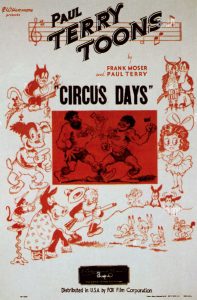 Circus Days (Terrytoons/Educational, 9/6/35) – A short aggregation of circus spot gags, with no specific plotline whatsoever. A routine parade shot of spinning circus elephants begins the festivities, followed by a camel, and a giant carrying a midget in the palm of one hand. (This shot features embarrassing use of perspective, as gaps between the characters in the foreground are filled in by views of other spectators in the far background on route to the show, who, despite their great distance from the camera, manage to keep pace so that they maintain the same spots on the screen throughout the shot. In order for this to be so, the characters in the far background would have to be running at a speed of about 200 miles er hour!) An escalator takes patrons to balcony seats, with the last few steps up provided by the moving humps of a camel. A gag is lifted from “Betty Boop’s Ker-Choo”, of the bleachers being filled by means of a reverse vacuum-tube, which travels across the seats spraying patrons into their seating positions. A trainer feeds three seals with fish out of a goldfish bowl, briefly causing them to convert shape into a trio of black sedans as they chase one fish bouncing down the road. An original song, “Oh, There’s Nothing Finer Than a Fish” is performed. Inside the big top, a “climbing mule” is introduced, who ascends the main pole of the arena – until a well-placed rock fired from a patron’s slingshot rips the costume to reveal two clowns inside the fake mule suit. A troupe of acrobats launches themselves to the trapeze, by mounting the heads of giraffes, then pulling upon their tails like the plunger of a pinball machine, causing the giraffes’ necks to retract, then spring forward to shoot the acrobats up to their positions. An elephant has a leopard jump through a hoop, borrowing the gag of scraping off the leopard’s spots in the process. The elephant sucks up the spots with his trunk, then sprays them back upon the leopard’s fur. Two tattooed strong men battle each other, mainly by having battleships tattooed upon their chests shoot at one another, until one makes a direct hit upon the other’s ship, sinking it beneath the illustrated waves as in Harman-Ising’s “I Love a Parade”). Finally, a trio of lions turns out to be not-so-fearsome, revealing in song that “We’re not from Borneo – We’re Hawaiian”, as they lower their manes to their waistline as grass skirts to perform a short hula dance.
Circus Days (Terrytoons/Educational, 9/6/35) – A short aggregation of circus spot gags, with no specific plotline whatsoever. A routine parade shot of spinning circus elephants begins the festivities, followed by a camel, and a giant carrying a midget in the palm of one hand. (This shot features embarrassing use of perspective, as gaps between the characters in the foreground are filled in by views of other spectators in the far background on route to the show, who, despite their great distance from the camera, manage to keep pace so that they maintain the same spots on the screen throughout the shot. In order for this to be so, the characters in the far background would have to be running at a speed of about 200 miles er hour!) An escalator takes patrons to balcony seats, with the last few steps up provided by the moving humps of a camel. A gag is lifted from “Betty Boop’s Ker-Choo”, of the bleachers being filled by means of a reverse vacuum-tube, which travels across the seats spraying patrons into their seating positions. A trainer feeds three seals with fish out of a goldfish bowl, briefly causing them to convert shape into a trio of black sedans as they chase one fish bouncing down the road. An original song, “Oh, There’s Nothing Finer Than a Fish” is performed. Inside the big top, a “climbing mule” is introduced, who ascends the main pole of the arena – until a well-placed rock fired from a patron’s slingshot rips the costume to reveal two clowns inside the fake mule suit. A troupe of acrobats launches themselves to the trapeze, by mounting the heads of giraffes, then pulling upon their tails like the plunger of a pinball machine, causing the giraffes’ necks to retract, then spring forward to shoot the acrobats up to their positions. An elephant has a leopard jump through a hoop, borrowing the gag of scraping off the leopard’s spots in the process. The elephant sucks up the spots with his trunk, then sprays them back upon the leopard’s fur. Two tattooed strong men battle each other, mainly by having battleships tattooed upon their chests shoot at one another, until one makes a direct hit upon the other’s ship, sinking it beneath the illustrated waves as in Harman-Ising’s “I Love a Parade”). Finally, a trio of lions turns out to be not-so-fearsome, revealing in song that “We’re not from Borneo – We’re Hawaiian”, as they lower their manes to their waistline as grass skirts to perform a short hula dance.
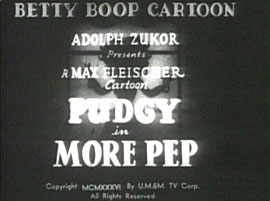 More Pep (Fleischer/Paramount, Betty Boop, 6/19/36 – Dave Fleischer, dir., Dave Hoffman/Thomas Johnson, anim.). Pudgy is usually mild-mannered and anything other than a star-struck show off. However, he curiously finds himself recruited into an unexpected situation. In a return to the format of Fleischer’s “Out of the Inkwell” cartoons, a human hand (supposedly of Max) paints in a background of a theatrical stage, including props for a daredevil act. An announcer (certainly not Max himself) provides the alleged voice of the studio head, delivering a high-intensity introduction in the manner of a circus ringmaster, describing the feat to be performed by “that daring, breathtaking, exciting exponent of wizardry in the air” – Pudgy! On the stage, Pudgy is to climb a platform, leap from it onto a trampoline, bounce onto a slide and perform a double loop-de-loop, then sail through a ring stuffed with razor-sharp knives. What did Pudgy do to deserve this treatment? Introductions completed, the spotlight turns to the stage wings, from which emerges out star – disinterested, drooping, and half-asleep, in no mood to be a daredevil. His eyelids drop, and he attempts to curl up for a siesta twice before even crossing the stage, and has to be prodded on by the insistent call of Max. He finally mounts the first platform, but his eyelids sag again. He now views the trampoline as a perfect hammock, and softly plops himself into its center, nodding off into a sound sleep.
More Pep (Fleischer/Paramount, Betty Boop, 6/19/36 – Dave Fleischer, dir., Dave Hoffman/Thomas Johnson, anim.). Pudgy is usually mild-mannered and anything other than a star-struck show off. However, he curiously finds himself recruited into an unexpected situation. In a return to the format of Fleischer’s “Out of the Inkwell” cartoons, a human hand (supposedly of Max) paints in a background of a theatrical stage, including props for a daredevil act. An announcer (certainly not Max himself) provides the alleged voice of the studio head, delivering a high-intensity introduction in the manner of a circus ringmaster, describing the feat to be performed by “that daring, breathtaking, exciting exponent of wizardry in the air” – Pudgy! On the stage, Pudgy is to climb a platform, leap from it onto a trampoline, bounce onto a slide and perform a double loop-de-loop, then sail through a ring stuffed with razor-sharp knives. What did Pudgy do to deserve this treatment? Introductions completed, the spotlight turns to the stage wings, from which emerges out star – disinterested, drooping, and half-asleep, in no mood to be a daredevil. His eyelids drop, and he attempts to curl up for a siesta twice before even crossing the stage, and has to be prodded on by the insistent call of Max. He finally mounts the first platform, but his eyelids sag again. He now views the trampoline as a perfect hammock, and softly plops himself into its center, nodding off into a sound sleep.
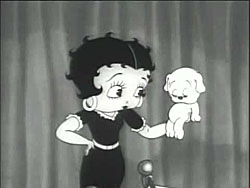 From the ink bottle at Max’s side, Betty emerges, laughing herself silly at Max’s total failure to get Pudgy to budge. “You seem to be having trouble, Uncle Max”, she calls out, barely restraining her giggles. “Say Betty, you’re just the one I want to see”, says Max. “No kiddin’”, laughs Betty. Betty volunteers to see what she can do to make the show go on. Grabbing Max’s pen, she begins singing a great little Sammy Timberg tune entitled “You Gotta Have Pep”, and devises her own means to put some life into the puppy. She draws a giant juicing machine, with a large chute for inserting all manner of ingredients for blending. Then, she draws a large refrigerator full of nutritious foods to use as raw ingredients. “Milk and eggs will give you dancing legs”, she sings, also adding “fruits and greens, peas and beans”. Everything goes into the blending apparatus, which indicates on a thermometer-like gauge the concoction’s reaching of the levels of vim, vigor, vitality, and finally pep, the mercury inside the tube reaching a near bursting point at the top. Suddenly, the machine goes haywire, and begins hopping around the stage as if alive. It starts to perform somersaults, sloshing its fluid contents every which way, then finally the machine hops out the window into the live-action world of New York, continuing its somersaults along the building ledge and splashing its super-powered contents everywhere. In clever use of speeded-up live action reference shots, a sandwich-sign street hawker quadruples his walking pace back and forth. A parade regiment trots through a military review at alarming velocity. New York vehicular and foot traffic becomes a visual blur. The juicer finally hops back in the animation studio window, and lands a dose of the miracle elixir upon Pudgy. The pup awakens from his siesta, so charged up that he breaks spontaneously into a rapid-fire Russian dance. He then zooms up the platform again, now taking his leap properly upon the trampoline, and within a split second or two has performed his double loop-de-loop and soar through the ring of blades. He’s so full of energy, he performs the same trick again – and again – then lands in Max’s ink bottle. The juicer follows right behind him, followed by Betty, who pauses before submerging into the bottle to say, “So long, Uncle Max.” “So long, Betty, and thanks a lot”, Max replies, replacing the bottle’s stopper for the traditional iris out of the good old days.
From the ink bottle at Max’s side, Betty emerges, laughing herself silly at Max’s total failure to get Pudgy to budge. “You seem to be having trouble, Uncle Max”, she calls out, barely restraining her giggles. “Say Betty, you’re just the one I want to see”, says Max. “No kiddin’”, laughs Betty. Betty volunteers to see what she can do to make the show go on. Grabbing Max’s pen, she begins singing a great little Sammy Timberg tune entitled “You Gotta Have Pep”, and devises her own means to put some life into the puppy. She draws a giant juicing machine, with a large chute for inserting all manner of ingredients for blending. Then, she draws a large refrigerator full of nutritious foods to use as raw ingredients. “Milk and eggs will give you dancing legs”, she sings, also adding “fruits and greens, peas and beans”. Everything goes into the blending apparatus, which indicates on a thermometer-like gauge the concoction’s reaching of the levels of vim, vigor, vitality, and finally pep, the mercury inside the tube reaching a near bursting point at the top. Suddenly, the machine goes haywire, and begins hopping around the stage as if alive. It starts to perform somersaults, sloshing its fluid contents every which way, then finally the machine hops out the window into the live-action world of New York, continuing its somersaults along the building ledge and splashing its super-powered contents everywhere. In clever use of speeded-up live action reference shots, a sandwich-sign street hawker quadruples his walking pace back and forth. A parade regiment trots through a military review at alarming velocity. New York vehicular and foot traffic becomes a visual blur. The juicer finally hops back in the animation studio window, and lands a dose of the miracle elixir upon Pudgy. The pup awakens from his siesta, so charged up that he breaks spontaneously into a rapid-fire Russian dance. He then zooms up the platform again, now taking his leap properly upon the trampoline, and within a split second or two has performed his double loop-de-loop and soar through the ring of blades. He’s so full of energy, he performs the same trick again – and again – then lands in Max’s ink bottle. The juicer follows right behind him, followed by Betty, who pauses before submerging into the bottle to say, “So long, Uncle Max.” “So long, Betty, and thanks a lot”, Max replies, replacing the bottle’s stopper for the traditional iris out of the good old days.
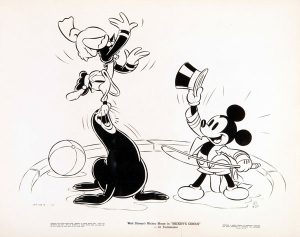 Mickey’s Circus (Disney/United Artists, Mickey Mouse, 8/1/36 – Ben Sharpsteen, dir.) – One might have thought that the gaudy splendor of circus trappings and decor would have been a natural early choice of subject matter for a color cartoon. Yet, surprisingly, it took nearly four years from the advent of three-strip color for anyone to get around to it. Of course, that someone would be Disney. Though not among the best known of Mickey’s episodes In the present day, the film may have been considered special by the studio in the times leading up to its release, as it originally included what was a rarity for Disney productions – an animated title card. The original opening footage, possibly lost, is represented in Disney’s morgue of accumulated artwork by three pencil drawings, depicting the gas bag of a hot-air balloon in three different angles of rotation, bearing on its side the title of the picture, as if seen floating over the circus grounds from an aerial vantage point. Not counting the prism rainbow curtain used on several 1933 Silly Symphonies, I am aware of only two other prior color films from Disney which may have included animated titles – the confirmed “Mickey’s Fire Brigade”, in which the title card burns away to reveal the first establishing shot, and the unconfirmed “Pluto’s Judgment Day”, soundtrack of which includes the barks of Pluto and yowls of a cat behind the reshot title card, suggesting that the dog and cat may have been chasing each other around the lettering in the original. One black and white film is also known to have added animation to its credits – “Mickey’s Good Deed”, in which falling snow was superimposed over the standard United Artists titles.
Mickey’s Circus (Disney/United Artists, Mickey Mouse, 8/1/36 – Ben Sharpsteen, dir.) – One might have thought that the gaudy splendor of circus trappings and decor would have been a natural early choice of subject matter for a color cartoon. Yet, surprisingly, it took nearly four years from the advent of three-strip color for anyone to get around to it. Of course, that someone would be Disney. Though not among the best known of Mickey’s episodes In the present day, the film may have been considered special by the studio in the times leading up to its release, as it originally included what was a rarity for Disney productions – an animated title card. The original opening footage, possibly lost, is represented in Disney’s morgue of accumulated artwork by three pencil drawings, depicting the gas bag of a hot-air balloon in three different angles of rotation, bearing on its side the title of the picture, as if seen floating over the circus grounds from an aerial vantage point. Not counting the prism rainbow curtain used on several 1933 Silly Symphonies, I am aware of only two other prior color films from Disney which may have included animated titles – the confirmed “Mickey’s Fire Brigade”, in which the title card burns away to reveal the first establishing shot, and the unconfirmed “Pluto’s Judgment Day”, soundtrack of which includes the barks of Pluto and yowls of a cat behind the reshot title card, suggesting that the dog and cat may have been chasing each other around the lettering in the original. One black and white film is also known to have added animation to its credits – “Mickey’s Good Deed”, in which falling snow was superimposed over the standard United Artists titles.
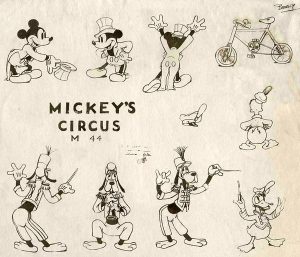 Mickey Mouse never learns. His charitable instincts always get the better of him, and, despite the chaos previously rendered by the local community of mouse orphans in such epics as “Orphans’ Benefit” and “Orphans’ Picnic”, he has opened up his new enterprise, a circus, for a day of free admission to orphans. Don’t say you weren’t warned, Mick. Our hero plays ringmaster, and introduces as first act Donald Duck and his performing sea lions (for brevity, we’ll call them seals). Donald, in a blue circus jacket that strongly resembles his usual sailor suit, plus a new sprightly cap with a feather in it, makes a grand entrance in the spotlight, carrying a very-large picnic basket, prominently labeled on the side “Fish”. He is followed by a troupe of three adult seals (one of whom performs an impersonation of Charlie Chaplin), and a baby seal, who is fixated on the fish basket, and just the right size to slip in and out of its wicker flaps. Donald joins the aquatic mammals in an exhibition of precision ball juggling, but at the end of the stunt has all balls tossed on his head by the seals, who want their pay-off in fish. Donald reaches into the basket, only to find the baby seal already inside, and engages in a losing game of tug of war over one of its large piscatorial delights. When Donald, distracted and in frustration, finally rescues one fish, he places it on his head instead of his hat. He is immediately mauled by the larger seals in a frenzied fight over the foodstuff, which leaves Donald buried in the sawdust of the center ring, while the little seal beats everyone to the punch and again makes off with the prize.
Mickey Mouse never learns. His charitable instincts always get the better of him, and, despite the chaos previously rendered by the local community of mouse orphans in such epics as “Orphans’ Benefit” and “Orphans’ Picnic”, he has opened up his new enterprise, a circus, for a day of free admission to orphans. Don’t say you weren’t warned, Mick. Our hero plays ringmaster, and introduces as first act Donald Duck and his performing sea lions (for brevity, we’ll call them seals). Donald, in a blue circus jacket that strongly resembles his usual sailor suit, plus a new sprightly cap with a feather in it, makes a grand entrance in the spotlight, carrying a very-large picnic basket, prominently labeled on the side “Fish”. He is followed by a troupe of three adult seals (one of whom performs an impersonation of Charlie Chaplin), and a baby seal, who is fixated on the fish basket, and just the right size to slip in and out of its wicker flaps. Donald joins the aquatic mammals in an exhibition of precision ball juggling, but at the end of the stunt has all balls tossed on his head by the seals, who want their pay-off in fish. Donald reaches into the basket, only to find the baby seal already inside, and engages in a losing game of tug of war over one of its large piscatorial delights. When Donald, distracted and in frustration, finally rescues one fish, he places it on his head instead of his hat. He is immediately mauled by the larger seals in a frenzied fight over the foodstuff, which leaves Donald buried in the sawdust of the center ring, while the little seal beats everyone to the punch and again makes off with the prize.
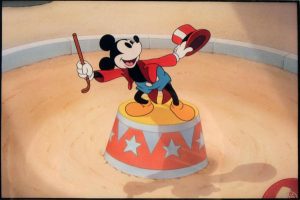 The next part of Donald’s act features one of the adult seals playing on a row of tuned horns, attempting a rendition of “Comin’ Thru’ the Rye”. Like Buhs Bunny and Private Snafu in their later renditions of “Those Endearing Young Charms”, the seal can’t seem to find the horn for the final note, and when Donald points it out by slamming upon it violently with his baton, the seal plays a note that sounds more like a raspberry. Suddenly, the act is upstaged by the baby seal, who “horns in” on the festivities to blow his own spritely rendition of “Yankee Doodle”. Donald attempts to chase the little seal away, but he reappears again under the velvet curtains of the instrument platform, playing his number on fife and drum as a one-man band. Donald chases the intruder away again, in the process getting caught up in the drum mechanism, and placing a cymbal on his head instead of his hat. The seals start raiding the fish basket again, so Donald protects it by standing upon it as a conductor’s platform, commanding the adult seal to resume his number. The big seal holds out, nonchalantly twirling his whiskers, until he is assured of a payoff on the form of an extra-large fish from the basket. At the sight of it in Donald’s hand, the seal takes off on a musical performance at light speed, his every movement a multiple-image blur, until he stands panting, waiting for his reward. He doesn’t get it, as the other seals appear again, stampeding Donald for the fish in his hand. Donald throws a forward pass, and the battling seals trample and flatten the horn platform, while the little seal again emerges out of the huddle, the only one who seems to be getting a square meal out of Donald’s fish supply.
The next part of Donald’s act features one of the adult seals playing on a row of tuned horns, attempting a rendition of “Comin’ Thru’ the Rye”. Like Buhs Bunny and Private Snafu in their later renditions of “Those Endearing Young Charms”, the seal can’t seem to find the horn for the final note, and when Donald points it out by slamming upon it violently with his baton, the seal plays a note that sounds more like a raspberry. Suddenly, the act is upstaged by the baby seal, who “horns in” on the festivities to blow his own spritely rendition of “Yankee Doodle”. Donald attempts to chase the little seal away, but he reappears again under the velvet curtains of the instrument platform, playing his number on fife and drum as a one-man band. Donald chases the intruder away again, in the process getting caught up in the drum mechanism, and placing a cymbal on his head instead of his hat. The seals start raiding the fish basket again, so Donald protects it by standing upon it as a conductor’s platform, commanding the adult seal to resume his number. The big seal holds out, nonchalantly twirling his whiskers, until he is assured of a payoff on the form of an extra-large fish from the basket. At the sight of it in Donald’s hand, the seal takes off on a musical performance at light speed, his every movement a multiple-image blur, until he stands panting, waiting for his reward. He doesn’t get it, as the other seals appear again, stampeding Donald for the fish in his hand. Donald throws a forward pass, and the battling seals trample and flatten the horn platform, while the little seal again emerges out of the huddle, the only one who seems to be getting a square meal out of Donald’s fish supply.
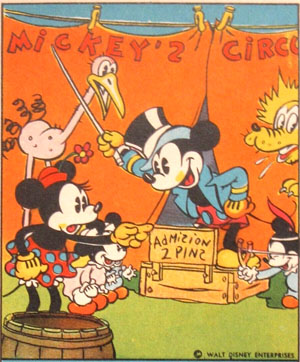 Donald takes off after the little seal, who in turn, takes off with the fish basket balanced atop his nose. The fish climbs into the barrel of a large artillery piece intended for the human cannonball act, and Donald follows. However, the seal emerges safely out the other end of the cannon. The orphans, who up to now have been watching all this hoopla from the bleachers, decide the time has come to stop being mere spectators, and to play a more proactive role in the proceedings. Before Donald can emerge out of the rear end of the cannon, they close the hatch upon him, trapping him inside. Mickey appears at the mouth of the weapon, telling Donald to come out before someone gets hurt – but instead is pushed himself into the cannon’s mouth by several meddlesome orphans wielding a cannon rammer pole. At a signal from one of the orphans, the trigger mechanism of the cannon is engaged, launching the mouse and duck skyward, together with the rammer pole and fish basket. Mickey lands upon the high wire, as the ram portion of the rammer breaks off, leaving him with a pole to use as a balance bar. Donald, seated in the fish basket, finds himself suspended from a rope and hook hanging from the top of the circus tent, which has hooked onto the handle of the basket. Camera angles shift to perspectives from high within the circus tent, as Mickey precariously attempts to keep his balance upon the wire. Donald, who feels comparatively safe where he is, laughs unmercifully at Mickey’s plight. He does not realize he himself is about to be thrust into the fray, as one of the orphas cuts the rope suspending him. Donald falls, and while the fish basket descends to the sawdust below, Donald lands upon the seat of a bicycle positioned on a platform at one end of the high wire – equipped with a spring-loaded launcher to shoot the bike out onto the tightrope. Donald frantically finds the bike pedals with his feet, attempting to gain some control of his own predicament, and with usual duck temper angrily yells for Mickey to get out of his way. As the bike approaches Mickey, he jumps. The bike zooms under his feet, while Donald intercepts Mickey’s balance bar, sliding over the top of it, and rejoining his bicycle at the other end of the bar. Donald pedals like mad to reach the safety of the platform at the other end of the wire, but the orphans are already one step ahead of him, squirting motor oil on their end of the tightwire. The bike wheels lose their traction, and Donald slides backwards.
Donald takes off after the little seal, who in turn, takes off with the fish basket balanced atop his nose. The fish climbs into the barrel of a large artillery piece intended for the human cannonball act, and Donald follows. However, the seal emerges safely out the other end of the cannon. The orphans, who up to now have been watching all this hoopla from the bleachers, decide the time has come to stop being mere spectators, and to play a more proactive role in the proceedings. Before Donald can emerge out of the rear end of the cannon, they close the hatch upon him, trapping him inside. Mickey appears at the mouth of the weapon, telling Donald to come out before someone gets hurt – but instead is pushed himself into the cannon’s mouth by several meddlesome orphans wielding a cannon rammer pole. At a signal from one of the orphans, the trigger mechanism of the cannon is engaged, launching the mouse and duck skyward, together with the rammer pole and fish basket. Mickey lands upon the high wire, as the ram portion of the rammer breaks off, leaving him with a pole to use as a balance bar. Donald, seated in the fish basket, finds himself suspended from a rope and hook hanging from the top of the circus tent, which has hooked onto the handle of the basket. Camera angles shift to perspectives from high within the circus tent, as Mickey precariously attempts to keep his balance upon the wire. Donald, who feels comparatively safe where he is, laughs unmercifully at Mickey’s plight. He does not realize he himself is about to be thrust into the fray, as one of the orphas cuts the rope suspending him. Donald falls, and while the fish basket descends to the sawdust below, Donald lands upon the seat of a bicycle positioned on a platform at one end of the high wire – equipped with a spring-loaded launcher to shoot the bike out onto the tightrope. Donald frantically finds the bike pedals with his feet, attempting to gain some control of his own predicament, and with usual duck temper angrily yells for Mickey to get out of his way. As the bike approaches Mickey, he jumps. The bike zooms under his feet, while Donald intercepts Mickey’s balance bar, sliding over the top of it, and rejoining his bicycle at the other end of the bar. Donald pedals like mad to reach the safety of the platform at the other end of the wire, but the orphans are already one step ahead of him, squirting motor oil on their end of the tightwire. The bike wheels lose their traction, and Donald slides backwards.
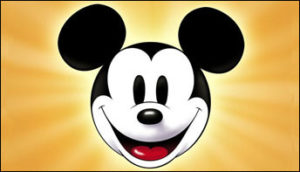 Again, he meets Mickey in the middle, this time with both he and the bike taking the overland route across Mickey’s balance bar. Donald reaches the platform where he started, and begins to dismount, but another of the orphans triggers the launching spring again, sending Donald for a third trip onto the wire. This time, Mickey’s pole somehow gets flipped into vertical position, with Donald’s bicycle precariously balanced high atop Mickey’s pole. Donald pauses long enough to kneel in prayer upon his bicycle seat, fearing the worst. The orphans ensure that there is reason for worry, sending a barrel rolling down the wire, which collides with Mickey with the sound effect of a bowling ball making a strike. The balance bar tips, and Donald finds himself riding off its end onto thin air. He slams on the brakes (although there is no surface to brake upon), reverses directions in mid-air, and regains a wheel footing upon the balance bar. The bar snaps in the middle, depositing Donald back upon the high wire. He rolls stage left, but encounters the same oil slick left previously, again causing a reversal of directions back toward Mickey. Mickey endures a head-on collision, finding himself riding on Donald’s handlebars in the middle of the wire. The orphans have saved the best for last – hooking the wire up to a high-voltage electrical box. Flicking a series of progressive switches, they increase the output from 110 to 220 to 4000 volts. The first jolts cause Mickey’s reflexes to engage in spasms, making him smack Donald repeatedly across the face with the balance bar. The full voltage makes both mouse and duck glow like neon, with their bicycle briefly splitting into twin unicycles. The power finally causes the wire to snap, and our heroes begin a long fall to the ground without a net. Fortunately, the orphans show a slight but of mercy, by wheeling in a large seal tank where Donald’s seals spend their off-time between acts. The mouse and duck each make a big splash, landing safely in the tank, and Donald comes up standing atop Mickey’s hat, happily taking bows before the cheering crowd, and even cheering himself on with calls of “Bravo, bravo!”. The baby seal responds with his own opinion of the performance, as he reaches into the fish basket, and tosses a large fish squarely between Donald’s open jaws. As if this were not humiliating enough, the three adult seals leap into the tank, for another battle royal over the fish, as the camera irises out on yet another moment of chaos and mayhem. Perhaps the wildest high-wire act ever filmed, and after almost ninety years, it still hasn’t been topped.
Again, he meets Mickey in the middle, this time with both he and the bike taking the overland route across Mickey’s balance bar. Donald reaches the platform where he started, and begins to dismount, but another of the orphans triggers the launching spring again, sending Donald for a third trip onto the wire. This time, Mickey’s pole somehow gets flipped into vertical position, with Donald’s bicycle precariously balanced high atop Mickey’s pole. Donald pauses long enough to kneel in prayer upon his bicycle seat, fearing the worst. The orphans ensure that there is reason for worry, sending a barrel rolling down the wire, which collides with Mickey with the sound effect of a bowling ball making a strike. The balance bar tips, and Donald finds himself riding off its end onto thin air. He slams on the brakes (although there is no surface to brake upon), reverses directions in mid-air, and regains a wheel footing upon the balance bar. The bar snaps in the middle, depositing Donald back upon the high wire. He rolls stage left, but encounters the same oil slick left previously, again causing a reversal of directions back toward Mickey. Mickey endures a head-on collision, finding himself riding on Donald’s handlebars in the middle of the wire. The orphans have saved the best for last – hooking the wire up to a high-voltage electrical box. Flicking a series of progressive switches, they increase the output from 110 to 220 to 4000 volts. The first jolts cause Mickey’s reflexes to engage in spasms, making him smack Donald repeatedly across the face with the balance bar. The full voltage makes both mouse and duck glow like neon, with their bicycle briefly splitting into twin unicycles. The power finally causes the wire to snap, and our heroes begin a long fall to the ground without a net. Fortunately, the orphans show a slight but of mercy, by wheeling in a large seal tank where Donald’s seals spend their off-time between acts. The mouse and duck each make a big splash, landing safely in the tank, and Donald comes up standing atop Mickey’s hat, happily taking bows before the cheering crowd, and even cheering himself on with calls of “Bravo, bravo!”. The baby seal responds with his own opinion of the performance, as he reaches into the fish basket, and tosses a large fish squarely between Donald’s open jaws. As if this were not humiliating enough, the three adult seals leap into the tank, for another battle royal over the fish, as the camera irises out on yet another moment of chaos and mayhem. Perhaps the wildest high-wire act ever filmed, and after almost ninety years, it still hasn’t been topped.
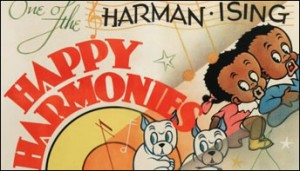 Circus Daze (Harman-Ising/MGM, Happy Harmonies (Bosko and Honey) – 1/16/37 Hugh Harman. dir.) It took Hugh Harman about a half a year to regroup and produce something in Technicolor to compete with the Mickey epic discussed above. Fortunately, for the most part, the temptation was avoided to merely color in old footage from I Love a Parade, although there remains a variant of the laughing clown closing in mouth-first upon the camera lens. Also, knowing he’d been topped for a routine on the high wire, no particular emphasis is placed on such act. Instead, we follow the modernized versions of Bosko and Honey (as black children), and Bosko’s dog Bruno, on an excursion through the big top, side show, and menagerie. The film opens with a montage of a high-striker, a marching band, a barker (in checkered trousers which prove a little too much for the dead-reckoning perspective of the animator, moving a bit awkwardly), a juggling clown on a unicycle, Fatima the dancing girl, and a hot dog vendor who fills buns with his own mustard-covered finger, then pulls it out when handing the product to the customer. As Bosko and a very excited Honey pass by the animal cages, Bruno encounters a cage containing two of Harman’s “good little monkeys” (making a cameo away from their own “See no evil, hear no evil” cartoons), who are busy removing fleas from each other’s backs. One is removed, and the monkeys begin chasing the insect, pounding with their hands and feet upon the floor in attempt to squash it. Bruno gets swept up in the excitement of the chase, and ignores Bosko’s commands to settle down, pulling as the leash tied around Bosko’s waist until his master is ducked repeatedly into a watering pail. The flea emerges from the monkey cage, and Bruno takes up the pursuit, also attempting to squash it upon the ground. Bosko declares he is “resasperated” with Bruno’s behavior, and orders Bruno to lie down. In a whining voice, Bruno complains that other dogs get to have fun, while he never gets to do anything. Bosko reminds him to watch his step – then stumbles right into the watering pail again.
Circus Daze (Harman-Ising/MGM, Happy Harmonies (Bosko and Honey) – 1/16/37 Hugh Harman. dir.) It took Hugh Harman about a half a year to regroup and produce something in Technicolor to compete with the Mickey epic discussed above. Fortunately, for the most part, the temptation was avoided to merely color in old footage from I Love a Parade, although there remains a variant of the laughing clown closing in mouth-first upon the camera lens. Also, knowing he’d been topped for a routine on the high wire, no particular emphasis is placed on such act. Instead, we follow the modernized versions of Bosko and Honey (as black children), and Bosko’s dog Bruno, on an excursion through the big top, side show, and menagerie. The film opens with a montage of a high-striker, a marching band, a barker (in checkered trousers which prove a little too much for the dead-reckoning perspective of the animator, moving a bit awkwardly), a juggling clown on a unicycle, Fatima the dancing girl, and a hot dog vendor who fills buns with his own mustard-covered finger, then pulls it out when handing the product to the customer. As Bosko and a very excited Honey pass by the animal cages, Bruno encounters a cage containing two of Harman’s “good little monkeys” (making a cameo away from their own “See no evil, hear no evil” cartoons), who are busy removing fleas from each other’s backs. One is removed, and the monkeys begin chasing the insect, pounding with their hands and feet upon the floor in attempt to squash it. Bruno gets swept up in the excitement of the chase, and ignores Bosko’s commands to settle down, pulling as the leash tied around Bosko’s waist until his master is ducked repeatedly into a watering pail. The flea emerges from the monkey cage, and Bruno takes up the pursuit, also attempting to squash it upon the ground. Bosko declares he is “resasperated” with Bruno’s behavior, and orders Bruno to lie down. In a whining voice, Bruno complains that other dogs get to have fun, while he never gets to do anything. Bosko reminds him to watch his step – then stumbles right into the watering pail again.
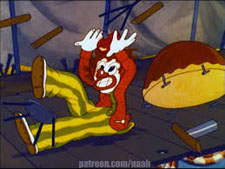 The monkeys find a new diversion, snatching Honey’s balloon through the bars of their cage. Bosko grabs at the gas-filled sphere, engaging in a tug-of-war over it, causing the knot in the monkeys’ end of it to become untied. Bosko us blown by the escaping gas into the aur, and onto the slide trombone of a clown in the circus band. The balloon becomes lodged in the bell of the trombone, and the clown’s spirited playing reinflates it, causing Bosko and the clown to rise into the air. Meanwhile, Bruno takes this opportunity to resume his pursuit of the flea. After being led in circles by the insect, Bruno follows it in a leap over a canvas partition – not realizing on the other side, in a glass enclosure, is an elaborate flea circus containing thousands of fleas within a mini-carnival of their own. The terrified dog lands with a crash amidst the display, releasing a living cloud of the insects. Bruno goes into a scratching fit, then attempts to run for safety, into the mouth of a cannon. The ringmaster lights a fuse for the human cannonball act, and Bruno is launched high into the tent, where he briefly grabs onto one of the pantlegs of the floating clown trombonist, then falls inro the bell of the tuba in the clown band below. The fleas, who have also followed Bruno into the cannon, are well dispersed by the cannon shot, and begin to rain down upon the band. Most of them land within the tuba, and are further dispersed by the tuba’s oom-pah notes. Quickly, everyone in the band is in scratching agony. A blast from the tuba sends Bruno and the flea cloud soaring toward a banner marking the tent exit. The banner serves as a slingshot, sailing Bruno and the fleas up to Bosko and the trombonist again. This time, Bosko and the clown are knocked loose from the balloon-bound trombone, as Bruno takes their place, with his head caught in the metal curve of the trombone slide. Bruno continues to sail aloft, with fleas still being deposited from his back all over the arena. Bosko and the clown fall back to the bandstand, joining the others in their scratching frenzy. A dog-faced boy bites at his rear end like a canine. An elephant, infested with the insects, breaks its chains, flipping upon its back in attempt to scrape off the little beasts, then charges the bandstand, crashing upon it. Bosko and the clowns are launched upward into the trapezes. Bosko ping-pongs between clowns, rebounding off their musical instruments, and returns to earth, aboard the neck of a giraffe. Now, the entire menagerie breaks loose from their cages, and all becomes a montage of chaos. Bosko and Honey escape the tent, miraculously not appearing to carry their weight in fleas once they emerge from the canvas enclosure. Bruno receives a more violent sendoff, being tossed out of the tent by the ringmaster with such force, his landing sounds the bell on the high-striker, for the iris out.
The monkeys find a new diversion, snatching Honey’s balloon through the bars of their cage. Bosko grabs at the gas-filled sphere, engaging in a tug-of-war over it, causing the knot in the monkeys’ end of it to become untied. Bosko us blown by the escaping gas into the aur, and onto the slide trombone of a clown in the circus band. The balloon becomes lodged in the bell of the trombone, and the clown’s spirited playing reinflates it, causing Bosko and the clown to rise into the air. Meanwhile, Bruno takes this opportunity to resume his pursuit of the flea. After being led in circles by the insect, Bruno follows it in a leap over a canvas partition – not realizing on the other side, in a glass enclosure, is an elaborate flea circus containing thousands of fleas within a mini-carnival of their own. The terrified dog lands with a crash amidst the display, releasing a living cloud of the insects. Bruno goes into a scratching fit, then attempts to run for safety, into the mouth of a cannon. The ringmaster lights a fuse for the human cannonball act, and Bruno is launched high into the tent, where he briefly grabs onto one of the pantlegs of the floating clown trombonist, then falls inro the bell of the tuba in the clown band below. The fleas, who have also followed Bruno into the cannon, are well dispersed by the cannon shot, and begin to rain down upon the band. Most of them land within the tuba, and are further dispersed by the tuba’s oom-pah notes. Quickly, everyone in the band is in scratching agony. A blast from the tuba sends Bruno and the flea cloud soaring toward a banner marking the tent exit. The banner serves as a slingshot, sailing Bruno and the fleas up to Bosko and the trombonist again. This time, Bosko and the clown are knocked loose from the balloon-bound trombone, as Bruno takes their place, with his head caught in the metal curve of the trombone slide. Bruno continues to sail aloft, with fleas still being deposited from his back all over the arena. Bosko and the clown fall back to the bandstand, joining the others in their scratching frenzy. A dog-faced boy bites at his rear end like a canine. An elephant, infested with the insects, breaks its chains, flipping upon its back in attempt to scrape off the little beasts, then charges the bandstand, crashing upon it. Bosko and the clowns are launched upward into the trapezes. Bosko ping-pongs between clowns, rebounding off their musical instruments, and returns to earth, aboard the neck of a giraffe. Now, the entire menagerie breaks loose from their cages, and all becomes a montage of chaos. Bosko and Honey escape the tent, miraculously not appearing to carry their weight in fleas once they emerge from the canvas enclosure. Bruno receives a more violent sendoff, being tossed out of the tent by the ringmaster with such force, his landing sounds the bell on the high-striker, for the iris out.
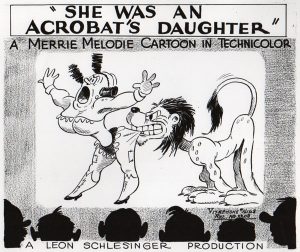 She Was an Acrobat’s Daughter (Warner, Merrie Melodies, 4/10/37 – I. (Friz) Freleng, dir.) – Despite its intriguingly on-point title for this survey, this film is really more of a candidate for an honorable mention. The title song was introduced by Joe E. Brown in a hard-to-see Warner feature, “Bright Lights”, where I believe it was properly cast within a circus setting. Here, it is only the subject of a series of “magic lantern” slides projected between features at a local movie house for a sing-along, accompanied by a theater organist (Stickoutski) playing a make of organ known as the “Fertilizer” (word play on the popular organ known as the Wurlitzer). The one verse of melody provided in the cartoon is interrupted by mistaken insertion of a slide reading “Please do not spit on the floor”, which the audience sings as if it were part of the lyric. The close of the number refers to said daughter’s lion taming act, with the words. “One bit her named Jack, and she bit him right back. In two days the poor lion died.” The remainder of the cartoon is a parody on the general theater-going experience, both with lampoons of the shorts and features which would generally appear on the screen, and cutaways to the goings-on of the patrons in the seats and aisles. Much of this film’s footage would be reused to compete the unfinished Bob Clampett production, “Bacall to Arms”, years later. Perhaps one of the most memorable bits in the film is its finale – a peek inside a vintage projection room, depicted in reasonably accurate detail, through the eyes of an intrusive juvenile duck who sneaks in while the projectionist has stepped away. The size of the equipment and the intensity of its spinning reels and gears reminds one of the heat and hazardousness that real-life projectionists must have endured in the days of nitrate projection – and of many unquenchable theater fires that literally brought down the houses. The joys of the silver screen sometimes came at a high personal cost, a factor we tend to forget in an era of modern digital projection. The little duck finds out the hard way that tasks above the heads of the paying customers aren’t all that easy, as he accidentally shifts the feature into super-speed projection backwards, gets his beak and then body trapped inside a maze of gears and sprockets, and ends up on the floor, being tangled in the ever-unspooling loops of several thousand feet of unwinding film, complaining his head off in sped-up dialogue for the iris out.
She Was an Acrobat’s Daughter (Warner, Merrie Melodies, 4/10/37 – I. (Friz) Freleng, dir.) – Despite its intriguingly on-point title for this survey, this film is really more of a candidate for an honorable mention. The title song was introduced by Joe E. Brown in a hard-to-see Warner feature, “Bright Lights”, where I believe it was properly cast within a circus setting. Here, it is only the subject of a series of “magic lantern” slides projected between features at a local movie house for a sing-along, accompanied by a theater organist (Stickoutski) playing a make of organ known as the “Fertilizer” (word play on the popular organ known as the Wurlitzer). The one verse of melody provided in the cartoon is interrupted by mistaken insertion of a slide reading “Please do not spit on the floor”, which the audience sings as if it were part of the lyric. The close of the number refers to said daughter’s lion taming act, with the words. “One bit her named Jack, and she bit him right back. In two days the poor lion died.” The remainder of the cartoon is a parody on the general theater-going experience, both with lampoons of the shorts and features which would generally appear on the screen, and cutaways to the goings-on of the patrons in the seats and aisles. Much of this film’s footage would be reused to compete the unfinished Bob Clampett production, “Bacall to Arms”, years later. Perhaps one of the most memorable bits in the film is its finale – a peek inside a vintage projection room, depicted in reasonably accurate detail, through the eyes of an intrusive juvenile duck who sneaks in while the projectionist has stepped away. The size of the equipment and the intensity of its spinning reels and gears reminds one of the heat and hazardousness that real-life projectionists must have endured in the days of nitrate projection – and of many unquenchable theater fires that literally brought down the houses. The joys of the silver screen sometimes came at a high personal cost, a factor we tend to forget in an era of modern digital projection. The little duck finds out the hard way that tasks above the heads of the paying customers aren’t all that easy, as he accidentally shifts the feature into super-speed projection backwards, gets his beak and then body trapped inside a maze of gears and sprockets, and ends up on the floor, being tangled in the ever-unspooling loops of several thousand feet of unwinding film, complaining his head off in sped-up dialogue for the iris out.
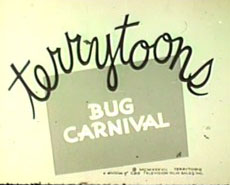 Bug Carnival (Terrytoons/Educational, 4/16/37) – Insects put on a combination carnival and circus. Advertisement for the event begins with a fly-by of three lightning bugs, their abdomens lighting up to display lighted signs reading “Bug” “Carnival” “Today”. At the ticket-taker’s booth, what appears to be a centipede enters on one ticket – but once inside the gate, he is revealed to be a line of little bugs standing in a row, who all scatter in different directions, cheating the establishment of a dozen prices of admission. The event features several unique amusement rides. A Ferris wheel powered by one insect running inside the wheel like a hamster. A “corkscrew coaster” where riders slide down curved leaves like a slide, ending with a twisting turn as they slide down the length of a corkscrew embedded in the ground. An airplane ride constructed of a spinning umbrella and seats made from carved-out acorns. A turntable ride atop a spinning record of a phonograph. At the side show, Zandow the Strong Man lifts a barbell above his head, which miraculously remains in mid-air, allowing him to perform chin-ups upon its bar. Freddie Firefly performs a fire-eating act, sticking a lighted matchstick into his abdomen, causing it to light up, then dousing the light as if a light bulb by merely turning his nose a half-click. Now for a main event, as a large beetle dressed as a lion tamer bravely enters a bottle containing a large spider. The act almost ends in disaster, as the spider pushes back the tamer’s chair, and chases him round and round inside the bottle. The tamer barely escapes out the bottle neck, two assistants replacing the bottle cork so hurriedly that the tamer is briefly caught up by his vest between the cork and the bottle.
Bug Carnival (Terrytoons/Educational, 4/16/37) – Insects put on a combination carnival and circus. Advertisement for the event begins with a fly-by of three lightning bugs, their abdomens lighting up to display lighted signs reading “Bug” “Carnival” “Today”. At the ticket-taker’s booth, what appears to be a centipede enters on one ticket – but once inside the gate, he is revealed to be a line of little bugs standing in a row, who all scatter in different directions, cheating the establishment of a dozen prices of admission. The event features several unique amusement rides. A Ferris wheel powered by one insect running inside the wheel like a hamster. A “corkscrew coaster” where riders slide down curved leaves like a slide, ending with a twisting turn as they slide down the length of a corkscrew embedded in the ground. An airplane ride constructed of a spinning umbrella and seats made from carved-out acorns. A turntable ride atop a spinning record of a phonograph. At the side show, Zandow the Strong Man lifts a barbell above his head, which miraculously remains in mid-air, allowing him to perform chin-ups upon its bar. Freddie Firefly performs a fire-eating act, sticking a lighted matchstick into his abdomen, causing it to light up, then dousing the light as if a light bulb by merely turning his nose a half-click. Now for a main event, as a large beetle dressed as a lion tamer bravely enters a bottle containing a large spider. The act almost ends in disaster, as the spider pushes back the tamer’s chair, and chases him round and round inside the bottle. The tamer barely escapes out the bottle neck, two assistants replacing the bottle cork so hurriedly that the tamer is briefly caught up by his vest between the cork and the bottle.
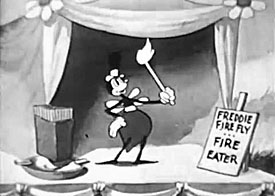 Inside a hollowed-out apple that serves as a dressing room, a sweet young fly applies facial powder in preparation for her act, at a make-up mirror and vanity constructed from an open tomato can. She is joined by her partner, and they both are catapulted on the handle of a spoon to the top or two daisy platforms, where they perform a trapeze act. The spider watches hungrily from within the bottle, then gets an idea. Running in revolutions within the bottle, the spider sets himself into a spin, then propels himself at the cork, unscrewing it from the bottle neck. Climbing atop one of the daisies, the spider attempts to grab the flies on the other daisy with two of its legs. However, he loses his grip, and the second daisy propels the fly couple into one of the acorn chairs of the umbrella airplane ride. The spider lands atop the spinning umbrella, but the umbrella ribs act like a buzz-saw upon his body, scraping away most of his fuzzy back covering. The spider leaps off, ducking under the umbrella to capture his prey, but only gets tied up in the metal spokes as the umbrella closes upon him. The flies squirt the spider with ink from a fountain pen, then hide behind a box. The spider meanwhile finds an eye dropper, and uses it to suck up the girl performer inside. The boy pursues the villain, using an egg-beater as a unicycle, and grabs away the eye dropper. The boy takes refuge inside a metal bracelet whose interior panels serve as a “hall of mirrors” attraction for the carnival. The spider climbs over the top, smashing at one reflection after another of the male fly, until about half of the mirrors are broken. He passes one that prominently displays the fly – but it is actually the real fly standing in front of the glass. The fly conks the spider on the head with a small club, then uses the spider’s feet as a staircase to climb out of the mirror hall, returning to release his girlfriend from the eye dropper, allowing for the standard lover’s kiss and iris out.
Inside a hollowed-out apple that serves as a dressing room, a sweet young fly applies facial powder in preparation for her act, at a make-up mirror and vanity constructed from an open tomato can. She is joined by her partner, and they both are catapulted on the handle of a spoon to the top or two daisy platforms, where they perform a trapeze act. The spider watches hungrily from within the bottle, then gets an idea. Running in revolutions within the bottle, the spider sets himself into a spin, then propels himself at the cork, unscrewing it from the bottle neck. Climbing atop one of the daisies, the spider attempts to grab the flies on the other daisy with two of its legs. However, he loses his grip, and the second daisy propels the fly couple into one of the acorn chairs of the umbrella airplane ride. The spider lands atop the spinning umbrella, but the umbrella ribs act like a buzz-saw upon his body, scraping away most of his fuzzy back covering. The spider leaps off, ducking under the umbrella to capture his prey, but only gets tied up in the metal spokes as the umbrella closes upon him. The flies squirt the spider with ink from a fountain pen, then hide behind a box. The spider meanwhile finds an eye dropper, and uses it to suck up the girl performer inside. The boy pursues the villain, using an egg-beater as a unicycle, and grabs away the eye dropper. The boy takes refuge inside a metal bracelet whose interior panels serve as a “hall of mirrors” attraction for the carnival. The spider climbs over the top, smashing at one reflection after another of the male fly, until about half of the mirrors are broken. He passes one that prominently displays the fly – but it is actually the real fly standing in front of the glass. The fly conks the spider on the head with a small club, then uses the spider’s feet as a staircase to climb out of the mirror hall, returning to release his girlfriend from the eye dropper, allowing for the standard lover’s kiss and iris out.
More late ‘30’s, next time.


 Charles Gardner is an animation enthusiast who toils by day as a member of LA Law – but by nights and weekends indulges in classic jazz and ragtime as a performer; and studies classic Hollywood cartoons… maybe a little too much.
Charles Gardner is an animation enthusiast who toils by day as a member of LA Law – but by nights and weekends indulges in classic jazz and ragtime as a performer; and studies classic Hollywood cartoons… maybe a little too much.


































































































































































“Of course, there were always laggers-behind, such as Terrytoons – but even there, as evidenced by the last title on today’s survey, a clever, well-drawn concept could occasionally be churned out.”
Glass of water and smelling salts for Jerry …
I wish a clearer version of “Circus Daze” were available. This one is more like looking through a “Circus Haze”.
For movie buffs, “Bug Carnival” has an amusing juxtaposition in its sideshow scene, where a stick insect billed as the “Thin Man” shares a stage with Zandow the Strong Man. Eugen Sandow was a world-famous circus strong man and bodybuilder. He was featured in a series of early films made by Edison in 1894, one of which was part of the very first commercial motion picture exhibition. In 1936 he was played by wrestler Nat Pendleton in the MGM musical biopic “The Great Ziegfeld”; and William Powell, who played the title role in that picture, also starred as “The Thin Man” in a popular series of films.
I wonder how many of those bratty orphans in “Mickey’s Circus” murdered their parents just so they could go to the circus for free. I wouldn’t put it past any of them.
Thanks for the article. I’d absolutely love to see the original titles to “Mickey’s Circus” and “Pluto’s Judgement Day”. A few other Disney cartoons are known to have animated title cards:
“The Haunted House” – at one point the letters which made up the title were blown away by the gust of wind which opens the short. I’ve never seen the originals, but a few frames from the end of this title exist on the non-theatrical reissue version.
“Trick or Treat” – An animated floating paintbrush paints the title on the window in the orginal RKO release. Not only this, but all the rest of the info for the title sequence are painted on one big background which pans across in time to the music (this is avaialable to see on Erik Palm’s excellent original titles YouTube Channel.
“Crazy Over Daisy” – This title is on a curtain which lifts up at the beginning of the cartoon. Judging by the sound at the end of the cartoon, it seems that the original end title was on a curtain which dropped back down, but I’ve only ever seen the reissue version.
Though not truly an animated title, one should also mention “Rugged Bear” (1953). In the original, Donald;s face is in a painting mounted in an oval frame above a hunting lodge fireplace, The camera pans down to the fireplace hearth, where the series banner ad director/animator credits appear framed in the blackness of the fireplace, then the camera pas down to the floor, revealing a bearskin rug, and the title of the film superimposed over the image. The original version of this appeared on the VHS/Laserdisc gold collection, and is also on the Erik website on Youtube. The Disney Treasured DVD only joins up with the original footage at the director’s card, and omits the Donald portrait and series banner.
“I Can’t Escape from You” (Paramount/Fleischer, Screen Songs, 25/9/36 — Dave Fleischer, dir.; Thomas Johnson and David Hoffman, anim.), one of the newsreel (or “Snooze Reel”) parodies in the series, deserves an honourable mention here for its unique twist on the kind of trained seal act seen in “Circus Days” and “Mickey’s Circus”, even though the action explicitly takes place in a zoo, not at a circus.
A keeper enters the seal enclosure and approaches the animal. The seal picks up a whip and cracks it, whereupon the keeper crouches submissively on all fours. The seal tosses a large beach ball to the keeper. He balances it on his nose, spins it and bounces it, then returns it when the seal cracks the whip again. The seal reaches into a bucket and throws a couple of fish to the keeper, who gobbles them hungrily. Just when you think you’ve seen everything, the keeper removes his clothes and a mask to reveal that he’s a seal himself!
In 1935 Lionel offered a Mickey Mouse Circus Train set. It featured an engine with Mickey shoveling coal, cars with printed images of other Disney characters, and a cardboard circus tent.
The toy’s artwork doesn’t evoke the cartoon, and the cartoon doesn’t include a train, but it seems just possible one casually inspired the other. Would be interesting to know if there was any mention in the cartoon’s press book, since it seems a natural for a local retail tie-in.
“Mickey’s Circus” is a prime example of the Technicolor pre-facelifted Mickey being in the center of things but largely peripheral as the other characters establish the action and get the laughs. It almost makes one wish “Band Concert” hadn’t been such a milestone for having instigated that particular formula. It caused Mickey’s downfall as a star and relegated him to the role of emcee.
Geez, I don’t think they knew it was going to be that hard to use Mickey as a main character during the switch for color. Besides, he was starting to share the spotlight with Donald and Pluto right before the switch to color.
The best here are Mickey’s Circus and She Was an Acrobat’s Daughter, which was really the first spot gag cartoon, statistically. Friz critics are in for a surprise. I also love the way Walt does Mickey’s dramatic shouting voice: “Doooonald…Duck…and his performiiiing…sea lions!!” If I were Donald I would’ve quit after five seconds.